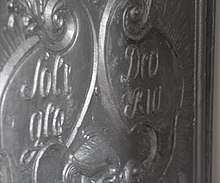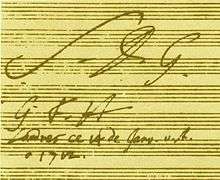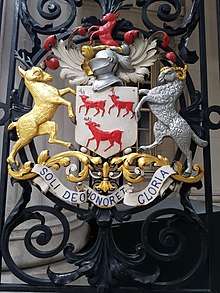Soli Deo gloria
Soli Deo gloria is a Latin term for Glory to God alone. It has been used by artists like Johann Sebastian Bach, George Frideric Handel, and Christoph Graupner to signify that the work was produced for the sake of praising God. The phrase has become one of the five solae propounded to summarise the Reformers' basic beliefs during the Protestant Reformation.
| Five solae of the Protestant Reformation |
|---|
| Sola scriptura |
| Sola fide |
| Sola gratia |
| Solus Christus |
| Soli Deo gloria |

As a greeting, it was used by monks in cistercian and trappist monastic orders in written comunication.[1]
As a doctrine, it means that everything is done for God's glory to the exclusion of mankind's self-glorification and pride. Christians are to be motivated and inspired by God's glory and not their own.
Meaning and related terms
The three words Soli Deo gloria (abbreviated S. D. G.) have meaning in Latin as follows: soli is the (irregular) dative singular of the adjective "lone", "sole", and agrees with the dative singular Deo, (in the nominative dictionary form Deus), meaning "to God"; and gloria is the nominative case of "glory","gloria".
Soli Deo gloria is usually translated glory to God alone,[2][3] but some translate it glory to the only God.[4] A similar phrase is found in the Vulgate translation of the Bible: "soli Deo honor et gloria".[5] This is grammatically the same as the signature of Bach and Handel, but using the dative "to the only God" then two nominative subjects "honour and glory." The verse reads differently in Greek and English because of the additional adjective "wise": ἀφθαρτῷ, ἀορατῷ, μόνῳ, σοφῷ Θεῷ, aphthartôi, aoratôi, mónōi, sophôi Theôi—"to the immortal, invisible, unique, wise God."
Musical and literary usage

The Baroque composer Johann Sebastian Bach wrote the initials "S. D. G." at the end of all his church compositions and also applied it to some, but not all, his secular works.[2] This dedication was at times also used by Bach's contemporary George Frideric Handel, e.g. in his Te Deum.[6] The 16th century Spanish mystic and poet St. John of the Cross used the similar phrase, Soli Deo honor et gloria, in his Precautions and Counsels.[7]
In tribute to Bach, the term was also chosen by Sir John Eliot Gardiner as the name for his own record label after leaving Archiv Produktion, to continue and complete his Bach cantatas project.
Aaron Shust's 2009 song "To God Alone (be the Glory)" was inspired by Bach's writing "S.D.G." at the bottom of his musical scores.[8]
Protestant usage in the Five Solae
Together with sola fide, sola gratia, sola scriptura and solus Christus, the phrase has become part of what is known as the Five Solae, a summary statement of central tenets of the Protestant Reformation.[9] Although these individual phrases have been used for centuries, it is not clear when they were first put together.
Other denominational views
In Eastern Orthodox and Roman Catholic theology, the term latria is used for the form of adoration and glorification directed only to the Holy Trinity.[10] The term dulia is used for saints in general and hyperdulia (below latria, above dulia) for the Virgin Mary.[11] The definition of the three level hierarchy of latria, hyperdulia and dulia goes back to the Second Council of Nicaea in 787.[12]
Mottos


Soli Deo Honor et Gloria is the motto of the Worshipful Company of Leathersellers, and appears on their gate at the entrance to St Helens Place, City of London. Soli Deo gloria is the motto of the Brotherhood of Saint Gregory, a Christian Community of friars of the Episcopal Church founded within the Anglican Communion in 1969; of Wheaton Academy, a high school located in West Chicago, Illinois, which was founded in 1853; of Concordia College (Moorhead, Minnesota); of Luther College, Decorah, Iowa; of Dordt College, Iowa founded in 1955; of the American Guild of Organists; of the Christ Presbyterian Academy in Nashville, Tennessee; of Ursuline High School, a Catholic high school located in Youngstown, Ohio which was founded in 1905; and of the Bishop's Stortford College, a British public school founded in 1868 in Bishop's Stortford, Hertfordshire. It is also imprinted on the South African 1 Rand coin.[13]
See also
- Apotheosis
- God Alone
- Veneration
- Subhan Allah
- Ad maiorem Dei gloriam
References
- P. Cyprian, O. S. B. "Father Cyprian Interviewed by John Vennari". Our Lady of Guadalupe Monastery.
- Butt, John (ed.). The Cambridge Companion to Bach. Cambridge Companions to Music. Cambridge University Press.
- The Routledge dictionary of Latin quotations: the illiterati's guide to Latin maxims, mottoes, proverbs and sayings, Jon R. Stone, Routledge, 2005 p. 207
- "Ursuline Sisters of Louisville – About the Ursulines".
- "1 Timothy 1:17 in the Vulgate". Latinvulgate.com. Retrieved 4 August 2012.
- Donald Burrows (2005). Handel and the English Chapel Royal. Oxford University Press. p. 103. ISBN 978-0-19-816228-5.
- Benedict Groschel (2010). I Am with You Always: A Study of the History and Meaning of Personal Devotion to Jesus Christ for Catholic, Orthodox, and Protestant Christians. Ignatius Press. p. 166. ISBN 978-1-58617-257-2.
- "To God Alone" with Aaron Shust – GreatWorshipSongs on YouTube
- Reformed Theology, by R. Michael Allen, Continuum International Publishing Group, 2010, p. 77 Archived 3 April 2015 at the Wayback Machine
- Catholic beliefs and traditions by John F. O'Grady 2002 ISBN 0-8091-4047-0 p. 145
- Trigilio, John and Brighenti, Kenneth The Catholicism Answer Book 2007 ISBN 1-4022-0806-5 p. 58
- The History of the Christian Church by Philip Smith 2009 ISBN 1-150-72245-2 p. 288
- "ZAR – South African Rand".
External links
- Articles on the five solas from a conservative Protestant perspective